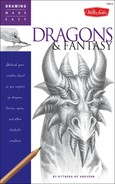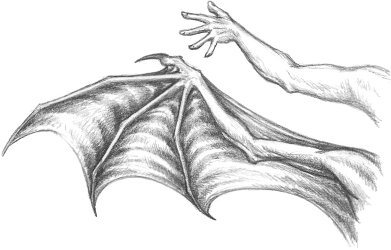Horns, wings, feathers, fur, claws: There are a lot of features and details to consider when designing your creatures! When drawing these features, keep in mind that it’s often helpful to use photo references of animals or humans with features similar to those you want to add to your fantasy drawings. This page will help you experiment with creating textures such as smooth scales and ridged horns, as well as with depicting elements such as wings and tails. And if you’re almost finished with a drawing and can’t shake the feeling that something is missing, consider some of these options to give your creature that last bit of oomph.

Scales Study existing scaly creatures, such as snakes, crocodiles, and even fish to get inspiration for scales. The scales above left are smooth and slick, like the belly of a snake. By keeping the shading light and blending away the edges of the scales where the lightest highlights are, the scales appear to be thin and flexible, like a fish. The scales above right, however, have very deep shading and are riddled with ridges, nicks, and cracks along the edges. These scales look very thick and hard—the sort that would make up the armor-like plates on an old, weathered dragon.

Claws Claws come in a wonderful variety of shapes and sizes and have many functions. Take a look at the examples in nature, such as tigers, eagles, lizards, and even dogs. Then think about the type of creature you are drawing and what purpose it might use its claws for. The example above left shows how long, thick talons might look on a gargoyle’s hand—useful for attacking, defending, and climbing. The middle example could be found on the toes of a dragon or harpy. Based on an eagle’s talon, this claw is good for hooking and grasping. The example above right is a good all-purpose claw with ridges.
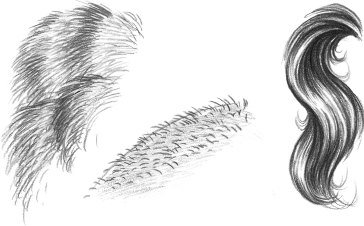
Fur and Hair When drawing short hair (above left), use medium-length strokes and avoid creating parallel rows, instead interspersing your lines and drawing them in the same general direction. Darker, denser lines can show stripes or other patterns and areas of shadow. Wiry, bristly hair (center) is drawn with short, quick pencil strokes. This is a good technique for drawing close-cropped hair or the stubble on an ogre’s knuckles and toes. The long hair shown above right is good for manes and tails. Use long, smooth lines that follow the direction of hair growth. To make the hair look shiny, let some of the white paper show through in areas. Not all hair is the same length, so let some lines trail off into wisps or curls for a more natural look.

Horns As with the other examples on this page, you can find ideas for your creature’s horns by modifying what you see in nature. Many animals have horns that are fantastically exotic, but something standard, like the curled ram horns above left, also works nicely for a range of fantasy creatures. Adding twists to smooth horns as in the middle example creates a refined look. In the above-right example, growth ridges can blend into smooth horn tips, creating a look that is both rough and dignified.
Leathery Wings Wings are, essentially, a second pair of arms and hands. The bones are thin and elongated, but the basic structure matches that of human hands and arms. Bats are the primary living example of this in that their forelimbs are their wings. In the example above, compare the “fingers” of the wing to the splayed fingers in the hand. Note that both limbs have a wrist, an elbow, a shoulder, and even a thumb. Keep this basic structure in mind, and then expand on it. Add more or fewer wing fingers, or consider long spikes that protrude from the elbow.
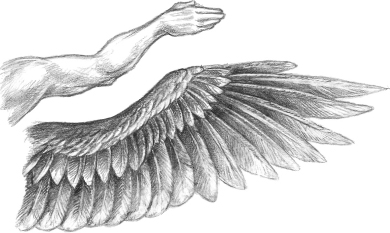
Feathered Wings Bird wings are also similar to human arms and hands. Unlike leathery wings where the wing is supported by elongated fingers, the “fingers” of a feathered wing are fused together. The feathers make up the bulk of the wing and give it its shape. Though feathers can be intimidating, you don’t need to draw every individual feather. Emphasize the primary feathers—the long feathers that look almost like fingers along the outer edge of the wing—and use less definition for the smallest feathers on the top layer (though you should emphasize the outer edges and perhaps show some markings).
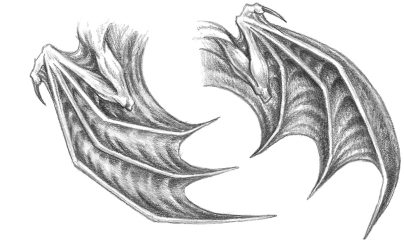
Folded Wings When not in flight, creatures usually fold their wings to keep them out of the way and to keep themselves safe. Folded wings can be held close to the body, or simply held low and relaxed. The membrane of wings—as with bats—is usually stretchy, even when relaxed. The examples above don’t show too much slack, other than folds between the wing fingers; however, you can also draw wings with folds that run parallel to the wing fingers and hang a bit like drapes when relaxed.
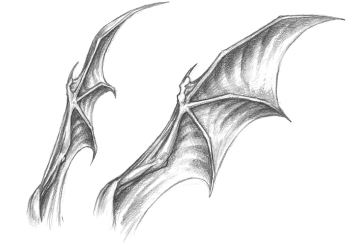
Open Wings When wings are open, the membrane between the wing fingers stretches and is pulled tight. Some folds are present, but not too many. Note that the edge of the membrane has a smoother arc where it stretches between the wing fingers, instead of the steep arc that occurs with folded wings. The example above left shows an open wing that is tilted away from the viewer.
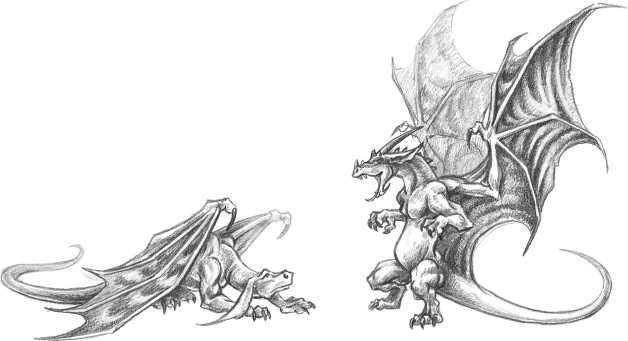
Expressive Wings Creatures are quite attached to their wings. When extra limbs are naturally part of a creature’s anatomy, they will come into play as another means of expressing that creature’s thoughts and feelings through body language. In this example, the dragon on the right is clearly agitated, spreading his wings to make himself look bigger and more intimidating. The dragon on the left is cowed by the other dragon’s display of aggression and is tucking his wings in close, as if to cower behind them in a submissive, non-threatening pose.
